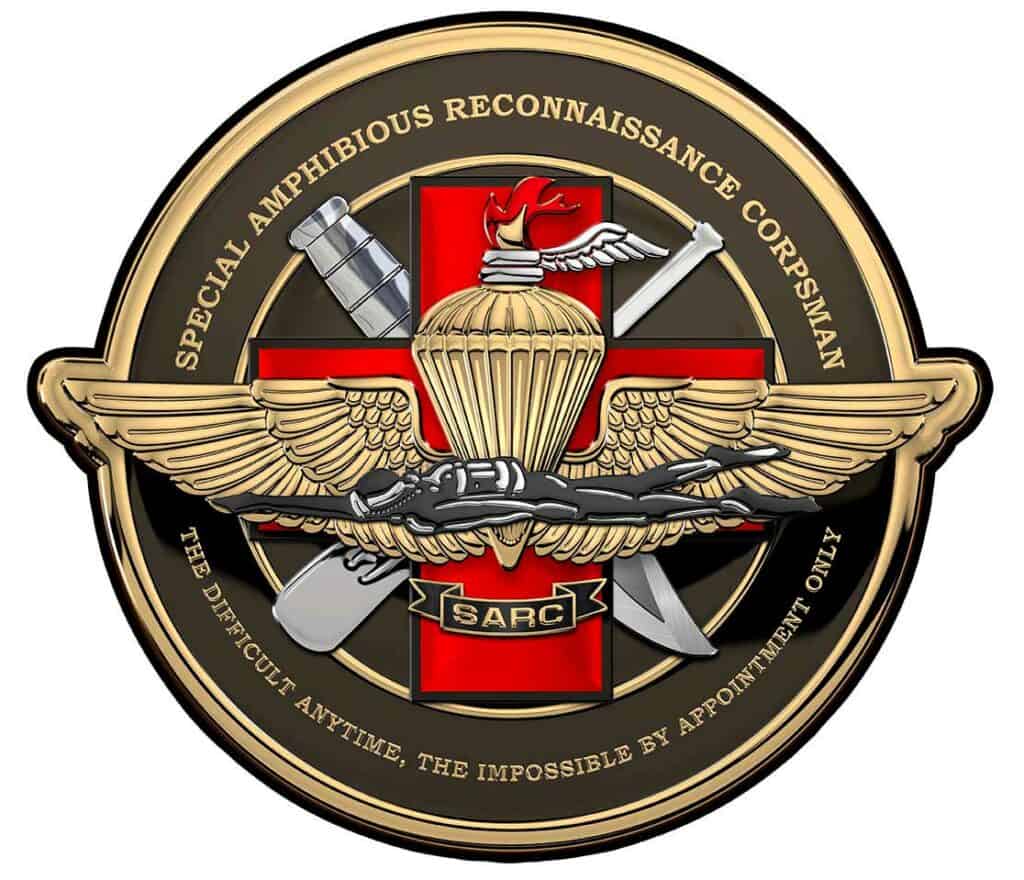
In today’s day and age, there are several professionals within the special operations world of medicine, but there’s one community that stands out amongst them. That is the Navy SARC.
What is a Navy SARC? SARC stands for Special Amphibious Reconnaissance Corpsmen.
Navy SARCs are highly trained corpsmen who operate in the world of special operations medicine and work in recon units, MARSOC, and Naval Special Warfare.
- Recon Units (Reconnaissance Marines): They are specialized infantry that gather information in combat zones.
- MARSOC (United States Marine Corps Forces Special Operations Command): MARSOC is the Marine Corps component of the United States Special Operations Command (USSOCOM or SOCOM).
- Naval Special Warfare (NSW): NSW is the Navy’s special operations force and the maritime component of the United States Special Operations Command (USSOCOM or SOCOM).
What makes Navy SARCs so valuable to the world of SOF (Special Operations Forces) medicine is that their entire purpose is medicine. It’s not a collateral duty for them. It’s literally what they do.
They are hospital corpsmen first, which are the enlisted medical assets of the Navy, and then are further trained to operate in Special Operations Forces (SOF) environments.
Don’t get that confused with the notion that all they do is medicine. That is quite the contrary.
While their primary purpose is medicine, they are trained just like an operator, meaning they also have a combative role on the battlefield.
And since Navy SARCs are corpsmen, that means that SARCs are only an enlisted job. If you want to be an officer, you cannot be a SARC. Keep that in mind.
While they are quite literally called Recon Corpsmen, they are also used in MARSOC and in DEVGRU, also known as SEAL Team Six.
They are actually becoming more utilized in Naval Special Warfare (NSW) because they receive so much training in medicine that they are considered a better asset to have than the Air Force Pararescuemen (PJs).
That’s not a knock on the PJs, though. It’s just the way it is.
One thing to note about Navy SARCs is that most of them spend their entire careers attached to Marine units. That means that while you’re officially in the Navy as a SARC, one could argue that you’re practically a Marine.
They receive the same training as Marines, wear the same uniform, and are treated as one of them while also sporting long hair and tattoos. Their official title is an SOIDC, which stands for Special Operations Independent Duty Corpsman.
This is essentially a fancy term that means that they are special operations medicine qualified personnel who can prescribe medicine and perform certain medical interventions and procedures on their own under the direction of a physician.
Independent Duty Corpsmen (IDCs) in the Navy, whether they’re in special operations or not, are essentially a physician’s assistant without the title. So we’ve clearly laid out to you that SARCs are SOF medical professionals.
- Independent Duty Corpsmen (IDCs) in the Navy serve in a capacity somewhat similar to that of a physician’s assistant.
- They’re medically trained personnel capable of providing medical care independently within their scope of practice.
They get the gold standard of medicine training at SOCM, which stands for Special Operations Combat Medic Course.
They do the short course and the long course, meaning they are the only other community besides the 18 Delta Special Forces Soldiers to do both.
At SOCM, they receive a plethora of medical training alongside other SOF medic communities, ranging from EMT (Emergency Medical Technician) training to clinic fundamentals, clinical medicine, trauma, and paramedic rotations.
At the end of SOCM, they take the paramedic exam and become registered paramedics. Once they finish SOCM, they receive their ATP card.
- ATP stands for Advanced Tactical Practitioner. An ATP card is a certification issued to Special Operations Forces (SOF) medics who have completed specialized medical training that is beyond the scope of a traditional paramedic, e.g., a Special Operations Combat Medic (SOCM) course.
Once they start the long course, known as SFMS, they receive full-on training in surgeries, dentistry, veterinary care, laboratory stuff, and much more.
- The Special Forces Medical Sergeant (SFMS) course, also known as the long course, is an advanced training program that Navy SARCs undergo after completing their Special Operations Combat Medic (SOCM) training.
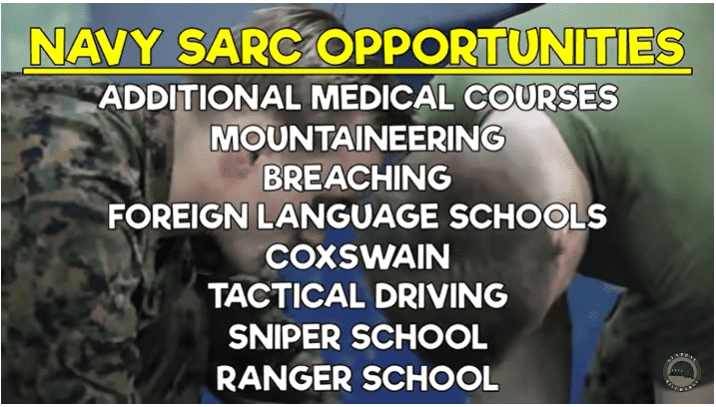
Okay, so you know what medical training a SARC gets and what makes them unique in the world of SOF medicine.
But do you know what opportunities they have? What about their pipeline? Let’s get into it.
As a Navy SARC, you have multiple opportunities to advance your skills as an operator, despite the fact that you’re a medical asset first and foremost.
Depending on the timing, funding, drive, and happenstance, a SARC can receive training with additional medical courses, mountaineering, breaching, foreign language schools, coxswain, tactical driving, sniper school on a very rare basis, and even ranger school is a possibility.
Again, this is all dependent on what unit you get placed in and where they are willing to send you.
| Training | Description |
|---|---|
| Additional medical courses | To expand your medical skills & knowledge |
| Mountaineering | Training in mountain survival & combat |
| Breaching | Instruction in forced entry tactics. |
| Foreign Language Schools | To learn a new language for more global capabilities. |
| Coxswain | Training to operate & command a ship’s boat |
| Tactical Driving | To learn high-performance driving techniques |
| Sniper School | Advanced marksmanship & fieldcraft training |
| Ranger School | It is rare but possible to enter Ranger School for advanced training. |
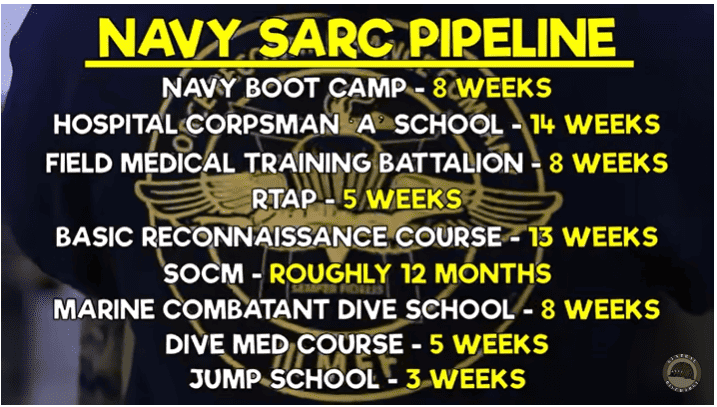
Let’s get into the pipeline of Navy SARCs. Their pipeline is one of the longest training pipelines out there for Special Operations Forces (SOF), so it will take some time for the Navy and Marine Corps to build you up to the standard they want.
The pipeline for Navy SARCs is as follows:
- Navy boot camp, which is eight weeks
- Hospital Corpsman (HM), A School, 14 weeks
- Field Medical Training Battalion, eight weeks
- RTAP (Reconnaissance Training and Assessment Program), five weeks
- Basic Reconnaissance Course, 13 weeks
- SOCM (Special Operations Combat Medic), roughly 12 months
- Marine Combat and Dive School, eight weeks
- Dive Med Course, five weeks
- Jump School, 3 weeks
As you can see, the pipeline is quite lengthy and challenging. That’s not even counting the weeks of hold you might be placed on between the courses.
Table 3: SARC Training Pipeline
| Training Phase | Duration |
|---|---|
| Navy Boot Camp | 8 weeks |
| Hospital Corpsman, A School | 14 weeks |
| Field Medical Training Battalion | 8 weeks |
| RTAP | 5 weeks |
| Basic Reconnaissance Course | 13 weeks |
| SOCM | Approximately 12 months |
| Marine Combat and Dive School | 8 weeks |
| Dive Med Course | 5 weeks |
| Jump School | 3 weeks |
What about where you can be stationed?
Since Navy SARCs work in Recon, MARSOC, and DEVGRU, they are stationed where they
- With the First Marine Raider Battalion moving to the East Coast in 2022, any SARC stationed with MARSOC will be at Camp Lejeune, North Carolina, as well as with the Second Recon Battalion.
- The First Recon Battalion is in Camp Pendleton, California, and the Third Recon is in Okinawa, Japan. They can also be placed in Dam Neck, Virginia; San Antonio, Texas; and Panama City Beach, Florida, for various billets.
| Station | Location |
|---|---|
| 1st Marine Raider Battalion/ 2nd Recon Battalion | Camp Lejeune, North Carolina |
| 1st Recon Battalion | Camp Pendleton, California |
| 3rd Recon | Okinawa, Japan |
| Various Billets | Dam Neck, Virginia |
| Various Billets | San Antonio, Texas |
| Various Billets | Panama City Beach, Florida |
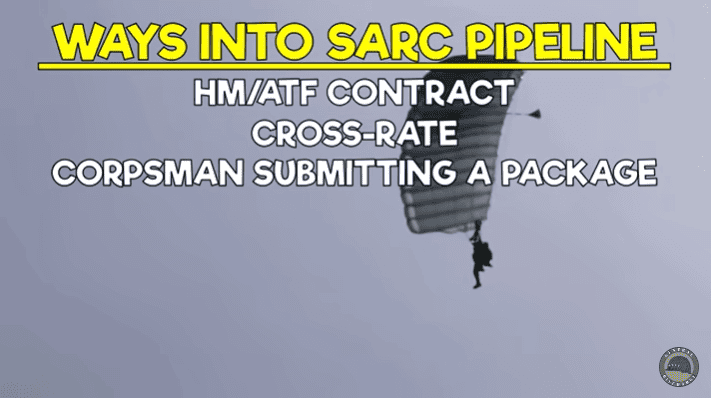
How does one start their journey on the path to becoming a Navy SARC?
It either starts with a civilian trying to earn an HM ATF contract, an active duty sailor who wants to cross-rate into a corpsman and take a shot at the pipeline, or someone who’s already a corpsman and wants to do something extra.
- HM ATF stands for Hospital Corpsman Advanced Technical Field.
- It is a contract a civilian must secure to begin training to become a Navy SARC.
The Navy has realized how important SARCs are and has ramped up its recruiting efforts toward the community. So there’s more awareness of the program among people.
You can always check the My Navy HR website to see the manning levels of the NEC (Navy Enlisted Classification) for recon corpsmen if you’re curious.
They have been understaffed for years but are starting to fill up more billets.
But before you even get a shot at the pipeline, you’re going to have to ace the Navy PST, which stands for physical screening test.
This is the screening that all Special Warfare and Special Operations candidates in the Navy have to conduct.
It consists of a 500 yard swim, pushups, situps, pullups, and a mile and a half run.
The minimums for Navy SARC are the same as SEAL standards, which are these.
| Test | SARC Minimum | SEAL Standard |
|---|---|---|
| 500-yard Swim | Equal/Less 12.30 Mins | Equal/Less 12.30 Mins |
| 50 Push-ups | 2 Mins | 2 Mins |
| 50 Sit-ups | 2 Mins | 2 Mins |
| 10 Pull-ups | 2 Mins | 2 Mins |
| 1.5-mile Run | Equal/Less 10.30 Mins | Equal/Less 10.30 Mins |
Obviously, those are the minimums, and you’ll have to put up much better numbers than that to get selected for training.
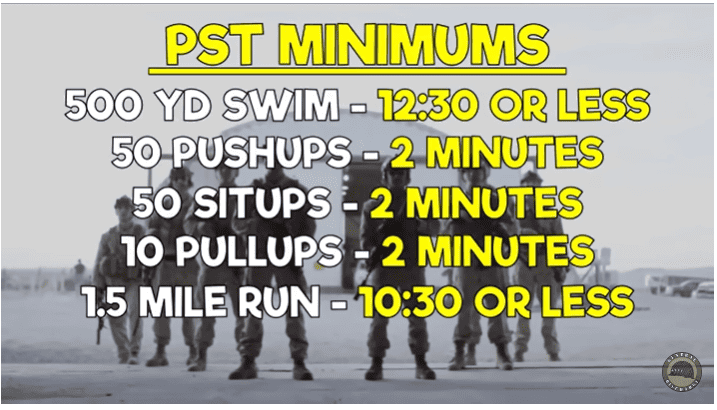
Conclusion
And that pretty much sums it up for the Navy SARC. We went over the following:
- What are they?
- What do they do?
- The training they go through
- The opportunities they have, and
- How to get the ball rolling if you want to be one of these professionals.
I have also covered other Special Operations Forces, Recon, and MARSOC as a whole.
- Empowering Transactions: Navigating Firearms Sales with Proper Documentation - April 8, 2024
- Army PRT – Preparation and Recovery 2024 - March 18, 2024
- Active and Reserve Components 2024 - March 6, 2024
